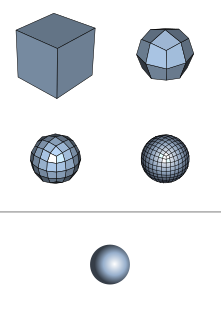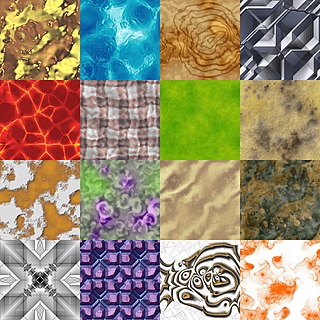
Gouraud shading, named after Henri Gouraud, is an interpolation method used in computer graphics to produce continuous shading of surfaces represented by polygon meshes. In practice, Gouraud shading is most often used to achieve continuous lighting on triangle surfaces by computing the lighting at the corners of each triangle and linearly interpolating the resulting colours for each pixel covered by the triangle. Gouraud first published the technique in 1971.

In computer science, binary space partitioning (BSP) is a method for recursively subdividing a space into two convex sets by using hyperplanes as partitions. This process of subdividing gives rise to a representation of objects within the space in the form of a tree data structure known as a BSP tree.
The RenderMan Interface Specification, or RISpec in short, is an open API developed by Pixar Animation Studios to describe three-dimensional scenes and turn them into digital photorealistic images. It includes the RenderMan Shading Language.

Information visualization or information visualisation is the study of (interactive) visual representations of abstract data to reinforce human cognition. The abstract data include both numerical and non-numerical data, such as text and geographic information. However, information visualization differs from scientific visualization: "it’s infovis [information visualization] when the spatial representation is chosen, and it’s scivis [scientific visualization] when the spatial representation is given".

Constructive solid geometry (CSG) is a technique used in solid modeling. Constructive solid geometry allows a modeler to create a complex surface or object by using Boolean operators to combine simpler objects. potentially generating visually complex objects by combining a few primitive ones.

A texel, texture element, or texture pixel is the fundamental unit of a texture map, used in computer graphics. Textures are represented by arrays of texels representing the texture space, just as other images are represented by arrays of pixels.

An isosurface is a three-dimensional analog of an isoline. It is a surface that represents points of a constant value within a volume of space; in other words, it is a level set of a continuous function whose domain is 3D-space.

A subdivision surface, in the field of 3D computer graphics, is a method of representing a smooth surface via the specification of a coarser piecewise linear polygon mesh. The smooth surface can be calculated from the coarse mesh as the limit of recursive subdivision of each polygonal face into smaller faces that better approximate the smooth surface.
James F. Blinn is an American computer scientist who first became widely known for his work as a computer graphics expert at NASA's Jet Propulsion Laboratory (JPL), particularly his work on the pre-encounter animations for the Voyager project, his work on the Carl Sagan documentary series Cosmos, and the research of the Blinn–Phong shading model.
In 3D computer graphics, a micropolygon is a polygon that is very small relative to the image being rendered. Commonly, the size of a micropolygon is close to or even less than the area of a pixel. Micropolygons allow a renderer to create a highly detailed image.
Geometric modeling is a branch of applied mathematics and computational geometry that studies methods and algorithms for the mathematical description of shapes.
The grid cell topology is studied in digital topology as part of the theoretical basis for (low-level) algorithms in computer image analysis or computer graphics.

In the geometry of computer graphics, a vertex normal at a vertex of a polyhedron is a directional vector associated with a vertex, intended as a replacement to the true geometric normal of the surface. Commonly, it is computed as the normalized average of the surface normals of the faces that contain that vertex. The average can be weighted for example by the area of the face or it can be unweighted. Vertex normals can also be computed for polygonal approximations to surfaces such as NURBS, or specified explicitly for artistic purposes. Vertex normals are used in Gouraud shading, Phong shading and other lighting models. Using vertex normals, much smoother shading than flat shading can be achieved; however, without some modifications, it cannot produce a sharp edge.
Morgan Kaufmann Publishers is a Burlington, Massachusetts based publisher specializing in computer science and engineering content.
Chandrajit Bajaj is an American computer scientist. He is a Professor of Computer science at the University of Texas at Austin holding the Computational Applied Mathematics Chair in Visualization and is the director of the Computational Visualization Center, in the Institute for Computational Engineering and Sciences (ICES).

In computer graphics, a procedural texture is a texture created using a mathematical description rather than directly stored data. The advantage of this approach is low storage cost, unlimited texture resolution and easy texture mapping. These kinds of textures are often used to model surface or volumetric representations of natural elements such as wood, marble, granite, metal, stone, and others.

Triangulation of a surface means
Amitabh Varshney is an Indian-born American computer scientist. He is an IEEE fellow, and serves as Dean of the University of Maryland College of Computer, Mathematical, and Natural Sciences. Before being named Dean, Varshney was the director of the University of Maryland Institute for Advanced Computer Studies (UMIACS) from 2010 to 2018.












